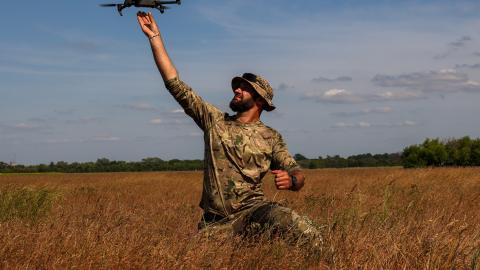This report first appeared as a part of Hudson's Re: Ukraine newsletter series. To subscribe, click here.
Below Hudson Senior Fellow Can Kasapoğlu offers a military situational report about the war in Ukraine.
1. Ukraine’s Counteroffensive Makes Incremental Advances, but No Breakthrough in Sight
Since the last edition of this report, the battlefield geometry of Ukraine’s counteroffensive has remained largely unchanged. The initial assaults originating from Velyka Novosilka and Orikhiv, with support from a coordinated effort in Vuhledar, have made incremental gains. Open-source monitoring suggests that the Velyka Novosilka axis comprises seven principal maneuver units and two artillery brigades taking active part in offensive operations. The Orikhiv axis features five mechanized brigades with support from one artillery brigade.
Along this axis Ukraine has struggled to make gains. The 47th Mechanized Brigade, one of the newly formed combat formations that has received extensive training and equipment from the West, suffered painful losses there, of Bradley Infantry Fighting Vehicles and Leopard-2 main battle tanks among other weapons in its arsenal. Russian artillery, minefields, and tactical aviation were able to halt the 47thbrigade and the 33rd brigade in their push to recapture occupied territory.
More important, Ukraine’s operational pauses and inability to muster sustained momentum are enabling Russian units to wage counterattacks. This has required the Ukrainian General Staff to send in a battle-hardened combat formation, the 93rd Mechanized Brigade, to stabilize the front against the Russian military’s 60th Motor-Rifle Brigade.
Russia’s resiliency in defensive operations during the opening stages of the counteroffensive exceeded the expectations of the Ukrainian high command. Indeed, the Ukrainian Armed Forces still have not engaged Russia’s main defensive lines. Nonetheless, while Kyiv has not yet delivered a shock assault collapsing the Russian lines, its counteroffensive is still in its early stages. Ukrainian combat formations have intensified their efforts to hit the Russian rear with HIMARS rockets. Ukrainian counter-battery salvos also are gaining in strength, as documented losses of Russian artillery pieces—including 2S19 Msta-S self-propelled howitzers—suggest. So while Ukraine has yet to overwhelm Russian forces, it would be premature to render a verdict on its counteroffensive.
2. Russian Tactical Aviation Stymies the Ukrainian Military
British intelligence reported this week that the Russian military has amassed over 20 gunships in the vicinity of the Zaporizhzhia front. The Berdyansk Airport, located some 100 kilometers from the front line, now hosts these rotary-wing assets that continue to prey on Ukrainian armor. Available satellite imagery intelligence confirms the British Ministry of Defense’s findings. Of these assets, the Russian Ka-52 Alligator attack helicopter has proved particularly menacing.
While the Russians have lost at least 35 Ka-52 platforms since the outset of the conflict, Russian tactical aviation poses a grave threat to Ukraine. In the absence of adequate maneuver short-range air defense (M-SHORAD) systems organically attached to mechanized units, Ukrainian armored platforms remain dangerously exposed. This threat cannot be mitigated by infantry squads with man-portable air defense systems (MANPADS), especially if Kyiv wishes to break through Russian lines. As Ukrainian combined arms warfare efforts drive deeper into Russian-occupied areas, they will need M-SHORAD to level the playing field.
3. Russian Nukes Arrive in Belarus
Vladimir Putin publicly confirmed this week that Russia has positioned tactical nuclear weapons in Belarus. While some experts claim this fails to alter the military balance in Eastern Europe, the ongoing nuclearization of Belarus is a turning point in Russia-NATO relations.
While the Russian arsenal in Belarus—the Su-24 frontal bomber, the Su-25 attack aircraft, and SS-26 Iskander ballistic missiles—does not provide a military game-changer, it perhaps puts the final nail in the coffin of the 1997 NATO–Russia Founding Act, in which Russia pledged not to threaten or use force against any NATO nation. With the Russian military running an invasion campaign at NATO’s frontiers, and NATO leaders characterizing the Russian Federation as a direct threat to the alliance, the situation in Belarus can only exacerbate the security situation in Europe. Putin is now capitalizing on the vulnerabilities of Belarusian leader Aleksandr Lukashenko—whose rhetoric had already become extremely anti-West following the 2020 protests against his rule in Minsk—and doubling down on nuclear escalation, transforming menacing rhetoric into military reality.
The move further integrates the Belarusian Armed Forces, which lack a nuclear deterrent of their own, into the Russian military apparatus. Since the Soviet Union’s strategic and tactical nuclear weapons deployed to Belarus once accounted for the sixth-largest nuclear arsenal in the world, the Kremlin’s policy also reflects the Russian elite’s dreams of resurrecting the glories of a former era.
4. Wagner at a Crossroads with the Russian Military Leadership
The Russian Ministry of Defense seeks to subordinate under one unified command structure all paramilitary, voluntary, and mercenary groups fighting alongside the Russian military. To do so, Minister of Defense Sergei Shoigu has ordered members of these groups to sign contracts with the Russian Ministry. Yevgeny Prigozhin of Wagner is defying these edicts in an effort to retain his shadow army’s independence.
The deadline for compliance with Shoigu’s orders is July 1, 2023. Ramzan Kadyrov’s Chechen units were the first to respond to the call. But Prigozhin refused to sign, claiming the requirement would weaken voluntary and private military groups by exacerbating problems with logisticsand discipline.
Adding insult to injury, Wagner is now announcing new recruitment opportunities in its ranks. The current Russian Ministry of Defense contract order marks a major fault line between Prigozhin and the Russian military gerontocracy represented by Shoigu and Chief of Staff General Valery Gerasimov. It remains to be seen if Prigozhin will submit or remain defiant.














